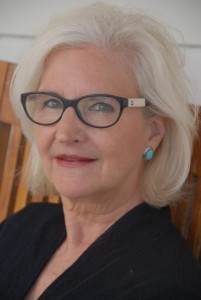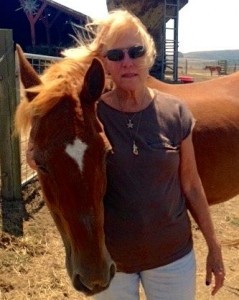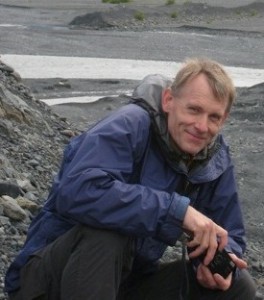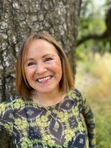Mary Reynolds Thompson's Blog, page 9
September 5, 2015
Valerie Andrews’ Wild Soul Story

Author of A Passion for this Earth: Exploring a New Partnership of Man, Woman and Nature, and editor for The Dream of the Earth by Thomas Berry, Valerie Andrews is no stranger to the importance of connecting to nature. In her vividly described Wild Soul Story, she invites us into her world growing up in New Jersey, where she shared her questions with the trees and read the landscape with braille fingers. Linking landscape and literature, inquiring into grandmothers and the land, Valerie’s stories crackle with insight, humor, and language that is grounded in a sense of place. Find out more about her organization “Sacred Words: A Center for Healing Stories,”and her many workshops, by visiting her website The Media Muse
The post Valerie Andrews’ Wild Soul Story appeared first on Mary Reynolds Thompson.
September 4, 2015
I Believe
I believe in steep drop-offs, the thunderstorm across the lake
in 1949, cold winds, empty swimming pools,
the overgrown path to the creek, raw garlic,
used tires, taverns, saloons, bars, gallons of red wine,
abandoned farmhouses, stunted lilac groves,
gravel roads that end, brush piles, thickets, girls
who haven’t quite gone totally wild, river eddies,
leaky wooden boats, the smell of used engine oil,
turbulent rivers, lakes without cottages lost in the woods,
the primrose growing out of a cow skull, the thousands
of birds I’ve talked to all of my life, the dogs
that talked back, the Chihuahuan ravens that follow
me on long walks. The rattler escaping the cold hose,
the fluttering unknown gods that I nearly see
from the left corner of my blind eye, struggling
to stay alive in a world that grinds them underfoot.
© Jim Harrison
Begin a list poem with the words, “I believe in…”
After writing your list poem, write a reflection piece that explores how you feel about the place you just described.
Underline the phrases in Jim Harrison’s poem that hold the most energy for you. Why do you think they evoke such a feeling response?
The post I Believe appeared first on Mary Reynolds Thompson.
Where Do I Belong?
In just four days I am headed to England, where my husband and I are renting a house in Salisbury for two months. I am anxious and full of anticipation. This is the longest I will have spent in my homeland in almost thirty years. What if I fall in love with England again? What if I don’t? What if the sacred stones of Stonehenge, just a few miles from where we are staying, cast their spell on me?
I left England in 1981 at age 25 for all kinds of reasons. I was an alcoholic running from the consequences of my behaviors, a wild spirit looking for ways to live more fully and freely, a young woman with a sense of adventure and a desire for new frontiers.
My first stop was New York City. On scant wages and with few options I lived in the South Street Seaport area, before it became chi-chi. Back then, it was a no-man’s land after dark. I remember still, the sound of my heels resounding on cobblestones as I turned into dark alleys, making my way home.
A year and a half later, I would land in San Francisco to be seduced by the brilliance of the Bay, the full-sailed boats sweeping beneath the Golden Gate Bridge, the tawny hills of Marin. I felt as if I had finally landed.
Now, though, I feel torn about my roots, where I belong, where I want to grow old. Leaving England was one of the greatest gifts I gave myself, but also one of the great griefs. I still remember the look on my parents’ faces when they attended my leaving party. Overnight, they had become old.
Now it’s just my Mum. She’s eighty-seven, and though rigorous for her age, her death no longer feels like a distant land. It will be reached sooner rather than later. Losing her will not only mean I will be the only survivor of my family of origin, but also the umbilical cord that ties me to England will be loosed.
So my husband and I will move between London and Salisbury, spending a lot of time with my mother in both places, but also feeling into what it is to live, if only for a short while, in England.
Will I long to return to America after a few weeks? Will the English weather cause me to crave California’s golden light?
Or will I feel my roots digging into the rich English soil, demanding of me answers to questions I can barely form?
The post Where Do I Belong? appeared first on Mary Reynolds Thompson.
Valerie Andrews’ Wild Soul Story

Author of A Passion for this Earth: Exploring a New Partnership of Man, Woman and Nature, and editor for The Dream of the Earth by Thomas Berry, Valerie Andrews is no stranger to the importance of connecting to nature. In her vividly described Wild Soul Story, she invites us into her world growing up in New Jersey, where she shared her questions with the trees and read the landscape with braille fingers. Linking landscape and literature, inquiring into grandmothers and the land, Valerie’s stories crackle with insight, humor, and language that is grounded in a sense of place. Find out more about her organization “Sacred Words: A Center for Healing Stories,”and her many workshops, by visiting her website The Media Muse
The post Valerie Andrews’ Wild Soul Story appeared first on Mary Reynolds Thompson.
August 14, 2015
Gift
A day so happy
Fog lifted early, I worked in the garden
Hummingbirds were stopping over honeysuckle flowers.
There was no thing on Earth I wanted to possess.
I knew no one worth my envying him.
Whatever evil I had suffered I forgot.
To think that once I was the same man did not embarrass me.
In my body I felt no pain.
When straightening up, I saw the blue sea and sails.
(C) Czeslaw Milosz
Write about “A day so happy….”
Where are you–and whom are you with–when you feel as if life is a gift?
How does this poem speak to you about what’s really important?
The post Gift appeared first on Mary Reynolds Thompson.
The Rapture of Being Alive
Ever since I was a little girl, I’ve checked to see if, when lying still or sleeping, the focus of my attention—–my cat, father, dog––was breathing. Even today, I wake in the middle of the night and listen for my husband’s breath, watch for the rise and fall of his chest, seek the reassurance that he is still––and miraculously—–alive.
My concerns also reach further afield, to encompass rivers, orangutans, forests, fish. How much of the planet is still thriving? How healthy are we? What in the world is still breathing?
All the death and destruction has me on edge. We live on a planet where life appears precarious, from the poisoning of our air and water to the destruction of the vitality within. How many more kids will we lose to suicides, school shootings, drugs and despair? How many more refugees will result from wars and climate change? What happens when days blur into hours spent staring at shimmering screens, a sea of techno-scintillation without soul?
The mythologist and writer Joseph Campbell put it this way: “People say that what we’re all seeking is a meaning for life. I don’t think that’s what we’re really seeking. I think that what we’re seeking is an experience of being alive, so that our life experiences on the purely physical plane will have resonances within our own innermost being and reality, so that we actually feel the rapture of being alive.”
The “rapture of being alive.” How can we take these words in and live them to the full in a world that seem dead set, pun intended, on self-destruction? Why might aliveness be the key to our salvation–– a touchstone or compass, that by following it, we can discover the root not only to our own rapturous aliveness, but to a fully alive planet as well?
A friend of mine, the shaman Claude Poncelet, was diagnosed with lung cancer, which metastasized to the brain, at about the time his book “The Shaman Within” came out. A vigorous man in his early seventies, Claude wanted above all else not to die. During a shamanic journey, his spirit guide turned to him and said, “It’s not enough to not want to die. You have to know why you want to live.”
Almost two years after his diagnosis, Claude told this story over the lunch table to my husband and me, “I knew it wasn’t going to be a simple answer—like so I can spend time with my grandchildren or write a second book. I was being asked to find a much deeper answer to that question. What does it mean to really want to live?”
I don’t have the answer. I’m not sure Claude does either… but it seems worthy, even vital work to ask, “What does it mean to really want to live?
The post The Rapture of Being Alive appeared first on Mary Reynolds Thompson.
August 13, 2015
Diane Conway’s Wild Soul Story

Author, humorous speaker and writing coach Diane Conway is not, by her own admission, a nature person. But when she encounters Sage, a full grown mustang, she discovers that between them runs a depth of connection that is both powerful and magical. What she will come to realize in her Wild Soul Story is that both she and Sage are survivors, and this shared experience of recovering from the wounds of the past creates a bond as deep as any she has encountered. You can discover more about Diane’s wonderful books, including her bestselling “What Would You Do If you Had No Fear?” by visiting her website.
The post Diane Conway’s Wild Soul Story appeared first on Mary Reynolds Thompson.
July 18, 2015
Lonner Holden’s Wild Soul Story

Lonner Holden grew up in Alaska, mountain trekking and backpacking in grizzly country. An avid wilderness explorer, he has floated the Yukon River, skied Denali, summited Mt. Shasta, and kayaked the Northern California coast. In 1972, he was a member of the first south-to-north land expedition to cross the Gibson and Great Victorian deserts of the Australian Outback. A poet, wilderness guide, and all-around outdoors man, Lonner’s profoundly moving Wild Soul Story takes us to the stormy oceans off the coast of Alaska, where he finds redemption in the visitation of a tiny sparrow. You can discover more about Lonner’s wilderness trips (including an breathtaking trip in the Grand Canyon) by visiting his website.
The post Lonner Holden’s Wild Soul Story appeared first on Mary Reynolds Thompson.
Identity
Let them be as flowers,
always watered, fed, guarded, admired,
but harnessed to a pot of dirt.
I’d rather be a tall, ugly weed,
clinging on cliffs, like an eagle
wind-wavering above high, jagged rocks.
To have broken through the surface of stone,
to live, to feel exposed to the madness
of the vast, eternal sky.
To be swayed by the breezes of an ancient sea,
carrying my soul, my seed,
beyond the mountains of time or into the abyss of the bizarre.
I’d rather be unseen, and if
then shunned by everyone,
than to be a pleasant-smelling flower,
growing in clusters in the fertile valley,
where they’re praised, handled, and plucked
by greedy, human hands.
I’d rather smell of musty, green stench
than of sweet, fragrant lilac.
If I could stand alone, strong and free,
I’d rather be a tall, ugly weed.
(c) Julio Noboa Polanco
Write a poem beginning with the words, “I’d rather be a [ name it]. Read it back to yourself. What surprised you? What did you discover about your identity?
Would you rather be an ugly weed or a a pleasant-smelling flower in the valley? Take out your journal and explore the differences and the pros and cons of each.
Who would you be if you lived strong and free?
The post Identity appeared first on Mary Reynolds Thompson.
July 1, 2015
The Yellow Dog Dream
Over a decade ago, camping in the forest at the retreat center of Hollyhock on the far northern Island of Cortes in British Columbia, a dream came to me that would shift the course of my life.
As I rested on the forest floor, soothed to sleep by the tiny crackle of insects, the rustle of leaves, and the musty fragrance of damp earth, I dreamed:
I am inside a large white tent filled with what looks like young boys dressed in wool coats, cloth caps, and stout boots. One by one, they move to the center of the tent to dance upon mandalas. Each taps out an aboriginal-style painting with his boots, creating an intricate and unique pattern within the circle.
Another boy begins to dance. I look at my watch and say, “We don’t have time for this.” That’s when I see the First Nation elders. They encircle the tent, long white hair falling almost to the floor, heads’ thrown back at pure joy at the boys’ dancing.
A yellow dog appears with a wide red stripe down his face. His fierce eyes lock on mine. In that moment I know: there is nothing more important than being able to dance our unique dance.
This photo of me, taken on our final evening at Hollyhock, represents the yellow dog who appeared to me in the dream. When his eyes locked on mine, he challenged me to see the world in a new way. I felt his determination not to let my linear need for expediency stop me from celebrating the beauty and particularity of each person.
Later, I would read of Jung’s work on the mandala, and how he noticed its appearance in all cultures across the globe. And that in each instance it represented the connection between the whole and the myriad, diverse ways in which it is expressed.
Stranger still, was a book that literally fell of a shelf in a bookstore and into my hands. It is called The Circle is Sacred: A Medicine Book for Women. In it, my dream is described in detail. The young boys are actually women dressed as men, seeking to balance their masculine and feminine energies. Writes the author Scout Cloud Lee, “Linear people cannot understand medicine teachings.” I blush thinking about me and that watch! Then she says, “Always at women’s circles, it is important to post dog soldiers to divert meddlesome spirits. One who is sensitive to energies or who is a seer will serve as a good dog soldier.”
Over time, I believe I am gradually integrating the lessons of this dream. I am learning to celebrate each person in their unique dance, however long it takes them (or me) to get there. I also believe that I have taken on some of the duties and even gifts of that dog soldier.
I am learning to divert those meddlesome spirits that can stop us from fulfilling our own unique and beautiful unfolding.
If you have a sacred dream to share, I’d love to hear it.
The post The Yellow Dog Dream appeared first on Mary Reynolds Thompson.



